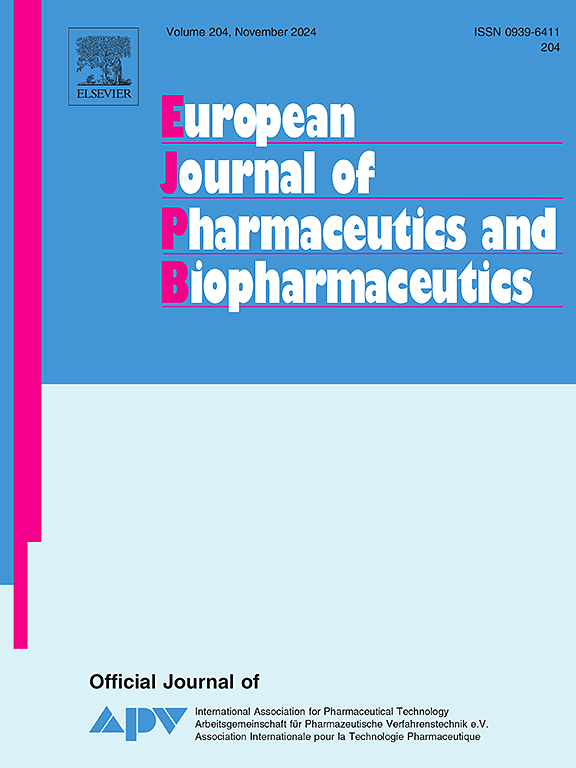Cationic Green Solid Lipid nanoparticles by the fatty acid coacervation method for gene delivery to the cornea: preliminary studies on cell and isolated tissue models
IF 4.3
2区 医学
Q1 PHARMACOLOGY & PHARMACY
European Journal of Pharmaceutics and Biopharmaceutics
Pub Date : 2025-06-17
DOI:10.1016/j.ejpb.2025.114795
引用次数: 0
Abstract
Gene augmentation therapy is an emerging approach to treat several corneal diseases, accounting for visual impairment and blindness worldwide. To this aim, in this preliminary experimental study, cationic Solid Lipid Nanoparticles (SLNs), obtained with the fatty acids coacervation method from natural soaps (Green SLNs), were used to prepare non-viral vectors for the green fluorescent protein encoding plasmid DNA (pDNA). Of note, Green SLNs contain oleic acid and the unsaponifiable fraction, that can act as a permeation enhancer and as an antioxidant, respectively. Stable vectors were obtained with and without the inclusion of hyaluronic acid. SLNs-based vectors were tested for pDNA binding/protection/release, and on in vitro and ex vivo corneal models for association and transfection capacity. pDNA was efficiently bound, protected and released from the vectors. In vitro studies on cell models showed a good cells association, but a poor transfection. Promising results were obtained in ex vivo transfection on rabbit corneas, in the case of vectors without hyaluronic acid, probably thanks to their oleic acid content.

通过脂肪酸凝聚法将阳离子绿色固体脂质纳米颗粒基因传递到角膜:细胞和分离组织模型的初步研究
基因增强疗法是一种新兴的治疗几种角膜疾病的方法,在世界范围内造成视力损害和失明。为此,在本初步实验研究中,采用脂肪酸凝聚法从天然肥皂(Green SLNs)中获得阳离子固体脂质纳米颗粒(SLNs),用于制备绿色荧光蛋白编码质粒DNA (pDNA)的非病毒载体。值得注意的是,Green sln含有油酸和不皂化的部分,它们分别可以作为渗透增强剂和抗氧化剂。在透明质酸和不含透明质酸的情况下获得稳定的载体。基于slns的载体进行了pDNA结合/保护/释放测试,并在离体和离体角膜模型上进行了关联和转染能力测试。pDNA被有效地结合、保护并从载体上释放。细胞模型的体外研究显示了良好的细胞关联,但转染效果不佳。在兔角膜的离体转染中获得了令人满意的结果,对于不含透明质酸的载体,可能是由于它们的油酸含量。
本文章由计算机程序翻译,如有差异,请以英文原文为准。
求助全文
约1分钟内获得全文
求助全文
来源期刊
CiteScore
8.80
自引率
4.10%
发文量
211
审稿时长
36 days
期刊介绍:
The European Journal of Pharmaceutics and Biopharmaceutics provides a medium for the publication of novel, innovative and hypothesis-driven research from the areas of Pharmaceutics and Biopharmaceutics.
Topics covered include for example:
Design and development of drug delivery systems for pharmaceuticals and biopharmaceuticals (small molecules, proteins, nucleic acids)
Aspects of manufacturing process design
Biomedical aspects of drug product design
Strategies and formulations for controlled drug transport across biological barriers
Physicochemical aspects of drug product development
Novel excipients for drug product design
Drug delivery and controlled release systems for systemic and local applications
Nanomaterials for therapeutic and diagnostic purposes
Advanced therapy medicinal products
Medical devices supporting a distinct pharmacological effect.

 求助内容:
求助内容: 应助结果提醒方式:
应助结果提醒方式:


